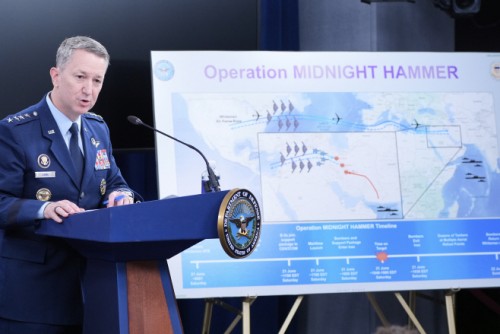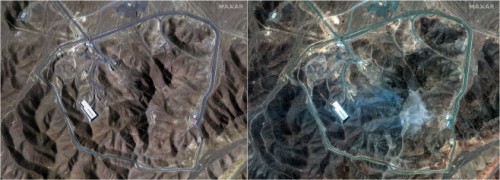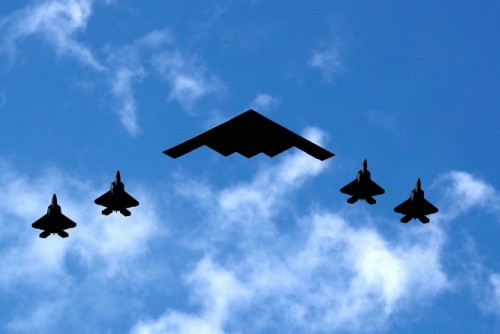 |
| Gen. Dan Kane, chairman of the U.S. Joint Chiefs of Staff, briefs reporters at the Pentagon in Arlington, Virginia, on June 22, following the airstrikes on three Iranian nuclear sites carried out the previous day. / Source: AP-Yonhap News |
The United States prepared for months in total secrecy before carrying out airstrikes on three of Iran’s major nuclear facilities on June 21, local time, the Pentagon revealed on June 22. The operation, named “Midnight Hammer,” marked the first combat use of the bunker-busting GBU-57 bomb, with multiple U.S. commands involved in the mission.
At a briefing held at the Pentagon in Arlington, Virginia, Defense Secretary Pete Hegseth and Joint Chiefs Chairman Gen. Dan Kane explained that extensive preparations had been made to ensure immediate execution once President Donald Trump gave the order. “We positioned military assets for weeks and prepared for months so we could act the moment the president commanded,” Hegseth said.
 |
| Satellite images provided by Maxar Technologies show Iran’s underground uranium enrichment facility in Fordow on June 20 (left), the day before the U.S. airstrikes, and on June 22, after the attack. / Source: Reuters-Yonhap News |
Gen. Kane emphasized the secrecy of the operation, stating, “This was a highly classified mission. Only a select few in Washington knew the timing and nature of the strike.” The goal, he said, was to significantly degrade Iran’s nuclear weapons capability.
According to Kane, the assault began at 2 a.m. Iran time (8 a.m. Korea time) with the dropping of two GBU-57 bombs. Prior to that, at midnight local time (6 a.m. KST), a U.S. Navy submarine launched more than 20 Tomahawk cruise missiles targeting the Isfahan nuclear facility.
 |
| A U.S. Air Force B-2 stealth bomber (center) and four Marine Corps F-35 fighter jets fly over the Hudson River and New York Harbor near New York City and New Jersey on July 4, 2020. / Source: Reuters-Yonhap News |
The GBU-57, also known as the “Massive Ordnance Penetrator,” was used in combat for the first time. Designed to destroy deeply buried targets, it weighs 30,000 pounds (13.6 tons) and contains 5,500 pounds of TNT. Only B-2 stealth bombers are capable of carrying it.
Kane described the mission as the largest-ever B-2 operation in U.S. history and the longest B-2 flight since the missions conducted after the September 11 attacks. A total of 14 GBU-57 bombs were dropped by seven B-2 bombers targeting the Fordow and Natanz nuclear sites. In total, about 75 precision-guided munitions, including cruise missiles, were used.
Ahead of the B-2s, 4th and 5th generation fighters entered Iranian airspace, indicating that aircraft such as the F-22 and F-35 may have carried out pre-emptive strikes against Iranian air defenses, according to a New York Times analysis.
 |
| Weapons specialists inspect a mock-up of the Massive Ordnance Penetrator (MOP) loaded into the bomb bay of a B-2 training aircraft at Whiteman Air Force Base in Missouri on December 18, 2007. / Source: U.S. Air Force-AFP-Yonhap News |
Over 125 aircraft participated in the operation, including B-2 bombers, stealth and conventional fighters, aerial refueling tankers, and ISR (intelligence, surveillance, and reconnaissance) aircraft.
Kane noted that Iran did not launch any fighter jets or surface-to-air missiles in response. “We maintained the element of surprise throughout the mission,” he said. It is still unclear whether any shots were fired at the approaching U.S. aircraft.
The operation involved deliberate deception tactics to mislead Iran and the media. While the main strike group of B-2 bombers departed from Whiteman Air Force Base in Missouri at midnight Eastern Time on June 21 (1 p.m. KST), a decoy group flew west toward the Pacific. U.S. media had reported that several B-2s appeared to be headed to Andersen Air Force Base in Guam, but this was part of the ruse.
“Only a handful of planners and senior leaders in Washington and at CENTCOM in Tampa knew about this deception,” Kane said.
The mission was led by U.S. Central Command, with support from U.S. Strategic Command, Transportation Command, Cyber Command, Space Command, the U.S. Space Force, and European Command.
Gen. Kane concluded, “This mission demonstrates the unparalleled capability and global reach of the U.S. military. As the president said last night, no other force in the world could have pulled this off.”
Most Read
-
1
-
2
-
3
-
4
-
5
-
6
-
7





















